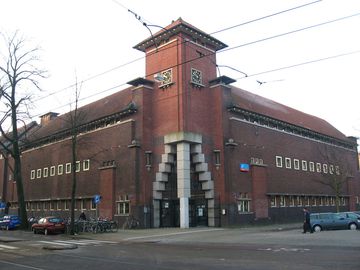

The New Pijp, as this southern part of De Pijpis officially known, was developed inthe late 19th and early 20th centuries as a testing ground for new styles of architecture. CornelisTroostplein offers many fine examples of the so-called Amsterdam School architecture, which thrived between 1910 and 1925. Although this style has no particular origins, it is believed to have come about as a reaction against the rational approach of such prominent and dominating Dutch architects as Berlage, who designed such notables buildings as the Amsterdam Stock Exchange, the Diamond Workers Union.Berlagewas responsible for the urban planning of the entire neighborhood to the south of De Pijp, known as Plan Zuid.
The Amsterdam School gave rein to the personal creativity and imaginationof each individual architect, andoften sacrificed functionality for the sake of a building’s appearance. The style is recognizable by the oddly-shaped windows and roofs, beautiful organic motifs and the use of wrought iron in combination with stone, concrete and tiles. The architects often drew inspiration from Symbolism, included sculpted elements into the facades and roofs, and borrowed Oriental ideas, such as the boat-shaped houses from Indonesia.
Not only was the Amsterdam School a new progressive architectural style, but the architects believed that the workers who populated De Pijp at the time had the right to beautiful houses and picturesque surroundings. The interiors thus often had elements intendedtoinspirethe buildings’ inhabitants. Cleverly, the architects also tried to manipulate the inhabitants’ attention towards home and family by raising the windows, so that the residents would not be tempted to chat with the neighbors nor be lured by the sight of the bardowninthe square below. The kitchens were also small, so that laundry, bathing and other unhygienic activities would have to be performed elsewhere. That latter ‘innovation’ resulted in much criticism that the apartments were ‘impractical’.
Ferdinand Bolstraat, named after one of Rembrandt’s most prominent pupils, connects the Heineken Brewery to the RAI Exhibition and Congress Center. Best known for its shopping, it’s one of the main thoroughfares that connects the neighborhood with the city center. At its north end it connects to the Vijzelstraat that runs all the way to the Dam Square, while to the south it opens onto Amsterdam’s most desirable and affluent OudZuid district. TheNorth-Southmetro line is currently being constructed and will run under the Ferdinand Bolstraat. The relatively narrow street makes it impossible to buildthe platforms on opposite sides. Instead they will be constructed one atop the other. In 2008 the city council decided that the stretch of this street between the Albert Cuyp and the Ceintuurbaan will remain a pedestrian zone after the metro construction is completed. The project has proved more complicated than expected, and numerous delays have sent it soaring way over budget, but it will hopefully open in 2017. The famous Amsterdam junk food chain FEBO is named after the Ferdinand Bolstraat and still runsits original cafejust south of the Albert Cuyp market.